
New Sweden was a Swedish colony along the lower reaches of the Delaware River in what is now the United States from 1638 to 1655, established during the Thirty Years' War when Sweden was a great military power. New Sweden formed part of the Swedish efforts to colonize the Americas. Settlements were established on both sides of the Delaware Valley in the region of Delaware, New Jersey, Maryland, and Pennsylvania, often in places where Swedish traders had been visiting since about 1610. Fort Christina in Wilmington, Delaware, was the first settlement, named after the reigning Swedish monarch. The settlers were Swedes, Finns, and a number of Dutch. New Sweden was conquered by the Dutch Republic in 1655 during the Second Northern War and incorporated into the Dutch colony of New Netherland.
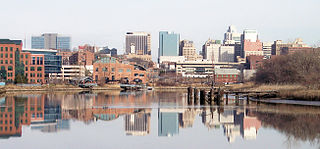
Wilmington is the largest city in the U.S. state of Delaware. The city was built on the site of Fort Christina, the first Swedish settlement in North America. It lies at the confluence of the Christina River and Brandywine Creek, two waterways near where the Christina flows into the Delaware River. It is the county seat of New Castle County and one of the major cities in the Delaware Valley metropolitan area. Wilmington was named by Proprietor Thomas Penn after his friend Spencer Compton, Earl of Wilmington, who was prime minister during the reign of George II of Great Britain.

Chester is a city in Delaware County, Pennsylvania, United States. It is located in the Delaware Valley on the western bank of the Delaware River between Philadelphia and Wilmington, Delaware. The population of Chester was 32,605 at the 2020 census.

The Hagley Museum and Library is a nonprofit educational institution in unincorporated New Castle County, Delaware, near Wilmington. Covering more than 235 acres (95 ha) along the banks of the Brandywine Creek, the museum and grounds include the first du Pont family home and garden in the United States, the powder yards, and a 19th-century machine shop. On the hillside below the mansion lies a Renaissance Revival garden, with terraces and statuary, created in the 1920s by Louise Evelina du Pont Crowninshield (1877–1958).

Brandywine Creek is a tributary of the Christina River in southeastern Pennsylvania and northern Delaware in the United States. The Lower Brandywine is 20.4 miles (32.8 km) long and is a designated Pennsylvania Scenic River with several tributary streams. The East Branch and West Branch of the creek originate within 2 miles (3 km) of each other on the slopes of Welsh Mountain in Honey Brook Township, Pennsylvania, about 20 miles (32 km) northwest of their confluence.

Pierre Samuel du Pont was an American entrepreneur, businessman, philanthropist and member of the prominent du Pont family.

John Jakob Raskob, KCSG was a financial executive and businessman for DuPont and General Motors, and the builder of the Empire State Building. He was chairman of the Democratic National Committee from 1928 to 1932 and a key supporter of Alfred E. Smith's candidacy for President of the United States.
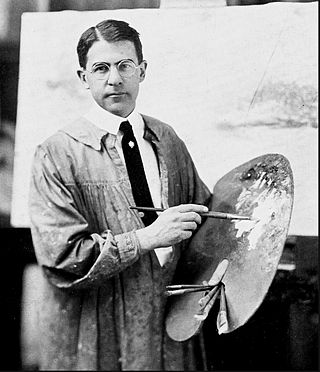
Frank Earle Schoonover was an American illustrator who worked in Wilmington, Delaware. A member of the Brandywine School, he was a contributing illustrator to magazines and did more than 5,000 paintings.
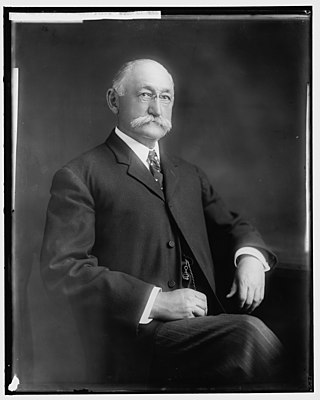
Preston Lea was an American businessman and politician from Wilmington, in New Castle County, Delaware. He was a member of the Republican Party who served as Governor of Delaware.
Richard Cann McMullen was an American manufacturer and politician from Wilmington, in New Castle County, Delaware. He was a member of the Democratic Party, who served as Governor of Delaware.
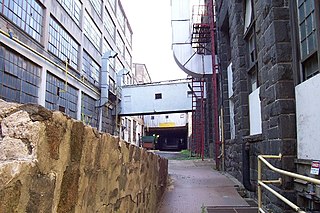
Bancroft Mills is an abandoned mill complex along Brandywine Creek in Wilmington, Delaware, United States. It has been the site of some of the earliest and most famous mills near Wilmington and was the largest and longest running complex along the Brandywine.

Francis Gurney du Pont was an American businessman and chemist who served as a vice president of E. I. du Pont de Nemours Company and invented smokeless gunpowder with the assistance of cousin Pierre S. du Pont. A member of the du Pont family, Francis had ten children, including E. Paul du Pont, founder of Du Pont Motors.

USS Monadnock (ACM-10) was a coastal minelayer in the U.S. Navy, the third vessel named after Mount Monadnock, a solitary mountain (monadnock) of more than 3,100 feet in southern New Hampshire close to the border of Massachusetts. The ship was built as the cargo vessel Cavalier for the Philadelphia and Norfolk Steamship Company by Pusey and Jones Corporation, Wilmington, Delaware in 1938. The Navy purchased the ship 9 June 1941 for wartime use. After decommissioning the ship was sold in June 1947 for commercial use then sold to a Panamanian company in 1949 to be renamed Karukara. In 1952 the ship became Monte de la Esperanza for a company in Bilbao, Spain transporting bananas to the United Kingdom from the Canary Islands for more than 20 years. She was later sold to the Marine Institute of Spain for operation as a hospital ship for more than 10 years serving the fishing fleet of the Canary Islands as Esperanza del Mar until becoming an artificial reef off Spain in 2000.
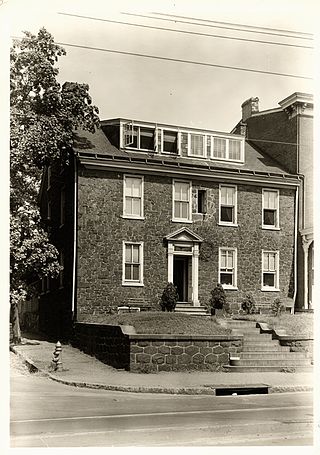
William Lea was a member of a prominent flour milling family in Wilmington, Delaware, who was largely responsible for the development of the Brandywine Mills to their place of importance.

The Delaware Historical Society began in 1864 as an effort to preserve documents from the Civil War. Since then, it has expanded into a statewide historical institution with several buildings, including Old Town Hall and the Delaware History Museum, in Wilmington and the historic Read House & Gardens in New Castle.

William du Pont Jr. was an English-born American businessman and banker, and a prominent figure in the sport of Thoroughbred horse racing. He developed and designed more than 20 racing venues, including Fair Hill at his 5,000-acre estate in Maryland. A member of the Delaware Du Pont family, he was the son of William du Pont and Annie Rogers Zinn, and brother to Marion duPont Scott, a noted horsewoman and breeder.
Mahlon Betts (1795–1867) was a carpenter, railroad car builder, shipwright, businessman, banker, and legislator who helped found three of Wilmington, Delaware's major manufacturing enterprises: the Harlan and Hollingsworth Company, the Pusey and Jones Company, and the Betts Machine Company.
The National Bank of Delaware was the first bank chartered in the U.S. state of Delaware. Based in Wilmington, the bank operated independently from 1795 to 1929, when it was merged into the Security Trust Company, also of Wilmington.
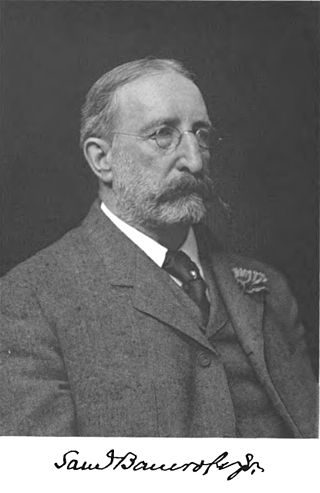
Samuel Bancroft was an American industrialist as well as a major collector of Pre-Raphaelite Brotherhood artwork. His appreciation for art and his desire to give back to the community led to his becoming a prominent philanthropist in the early 20th century, particularly of the Brandywine School.















